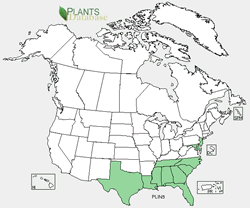Plant of the Week
 Platanthera integra range map. USDA PLANTS Database.
Platanthera integra range map. USDA PLANTS Database.
 Yellow Fringeless Orchid (Platanthera integra). Photo by Thomas Philipps.
Yellow Fringeless Orchid (Platanthera integra). Photo by Thomas Philipps.
 Yellow Fringeless Orchid (Platanthera integra) habitat. Photo by Thomas Philipps.
Yellow Fringeless Orchid (Platanthera integra) habitat. Photo by Thomas Philipps.
Yellow Fringeless Orchid (Platanthera integra (Nutt.) Gray ex Beck)
By Thomas C. Philipps
In Texas, the yellow fringeless orchid (Platanthera integra) is extremely rare. Until recently, the only known Texas documentation was a collection by Thomas Drummond in the 1800s, but now we now know that this was based on a misidentification. Plant taxonomist W.C. Holmes (1983) discovered that the specimen had been misidentified when he was investigating the distribution and rarity of the orchid in Louisiana, Mississippi, and Texas. At the Gray Herbarium, he examined the Drummond specimen from Texas and determined that is was clearly Platanthera nivea (Snowy Orchid), not P. Integra. With this finding by Holmes, it seemed likely that the yellow fringeless orchid never grew in Texas. Some botanists believe that even if this orchid had ever occurred in Texas, it was probably extinct today.
In 1987, Steve Orzell, a botanist formerly with the Texas Parks and Wildlife Natural Heritage Program, and botanist Edwin Bridges located a herbarium specimen of P. integra collected from Texas. While examining specimens at the University of Texas herbarium, a particular orchid attracted their attention. Mrs. J.L. Hooks had collected the plant on August 30, 1950, and correctly identified it as Habenaria integra, the former name of P. integra. However, an anonymous individual had penciled in a notation on the specimen “correcting” her classification to Habenaria nivea, so the specimen was filed under the incorrect name. Orzell and Bridges affirmed that Mrs. Hook’s original identification was correct, which meant that Platanthera integra had been seen in Texas as late as the mid-twentieth century. This inspired Orzell and Bridges to search for the orchid in the wild. In August 1988 they found two populations growing in hillside seepage slope bogs in Jasper and Angelina Counties (the latter on the Angelina National Forest), conclusively dispelling the notion that the yellow fringeless orchid was extinct in Texas.
Since then, Platanthera integra has only been seen an additional two times at the site of the Angelina National Forest population. The first time was in 1998. The most recent occurrence occurred in 2007 when botanists Tom Philipps, Peter Loos, and Joe Liggio discovered four flowering specimens in one of the hillside seepage slope bogs where the species was originally documented by Orzell and Bridges in 1988. All findings have occurred following the application of prescribed fire the previous winter or spring, which may suggest that this species requires fire as a stimulus for flowering and subsequent seed production.
For More Information
- PLANTS Profile - Platanthera integra, Yellow Fringeless Orchid
- “Wild Orchids of Texas” Joe and Ann Liggio, University of Texas Press, 1999. Used by permission.

